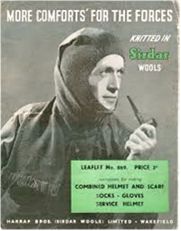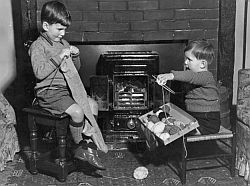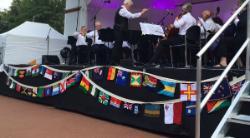Knitting in the Round: Hand-Knitted Textiles and the Economies of Craft in Scotland

About the project
This network will develop collaborations between a range of sectors: business, heritage, education, tourism and culture and arts; and will explore how historical understandings of knit as an economic, creative and cultural practice inform modern and contemporary uses of this textile practice. Knit is the pin-up craft for sustainability, creativity and authenticity. 
Knitting in the Round will investigate the transformation from small-scale, home-based craft production to one of Scotland's most identifiable brands and it will explore the relationships that knit facilitates: between young and old, across continents, between practitioners and researchers, producers and consumers, in the Scottish and international context.
Through a series of events combining practice and theory we will interrogate the meaning of knit in the present and the past. The result will be greater public understanding of the ways in which knit contributes to the Scottish economy, to health and wellbeing and to cultural enrichment.
This project builds upon an RSE funded series of Workshops in 2011-12 on the theme of 'Hand-knitted Textiles and the Economies of Craft in Scotland'
Contact us:
Study Day: Authenticity in Culturally Based Knitting - 5 March 2016
This workshop explored definitions of ‘traditional’ in Shetland knitwear design, the promotion, branding and marketing of ‘authentic’ Shetland knitwear, and how designers and industry are helped or hindered by a strong basis in heritage. These issues have implications for other types of craft, beyond textiles.
The workshop was broadcast live online and a recording of the event can be seen below. Please note that to make the workshop available quickly this recording is unedited. An edited version will be available soon.
19th Century Lace Patterns - Oct 2015
Call for Knitters: 19th Century Lace Patterns
This call is now closed!
How do you define authentic traditional knitwear? Does knitting have to be done in its cultural birthplace by indigenous people to be authentic?
The University of Glasgow and Shetland Museum and Archives are working on a joint project looking at published knitting patterns identified as ‘Shetland’ in mainland Scottish and English publications from the 1840s to the 1870s.
Most early patterns did not have an illustration so it is difficult to know if, or how much, the patterns resemble actual Shetland lace articles in collections. The only way to find out is to knit them. To this end we are looking for volunteers to knit samples from a selection of early knitting pattern books. The finished samples will form the core of an exhibition at Shetland Museum and Archives about the connection between 19th century patterns published nationally and knitwear made in Shetland of the period.
Instructions
- The patterns should be knitted as they are instructed in the book. The pattern will be provided as a pdf. Any text not related to the pattern to be knitted has been covered over. This means that there may be blank spaces on the sheet.
- The sample should be knitted to approximately six inch square (or three pattern repeats if six inches is two pattern repeats or less).
- For the samplers we are less concerned with needle size although if the pattern specifies a needle size and you have needles of that size (or close), this would give us a clearer indication of the intention of the pattern writer. As for yarn, all we would ask is that the yarn is not too thick or fluffy, so that we can see the pattern clearly.
- It is impossible at this point to say which patterns are easy or difficult. As such volunteers will be sent a random pattern to knit to sample. If you find the pattern too challenging but still wish to participate, we will be happy to forward a further pattern. Volunteers can request as many patterns to knit as they wish.
- Unfortunately we are on a very strict, and limited, timeline. We appreciate that many knitters will be in the throes of Christmas knitting but hope that we can entice you to participate and knit a six inch sample(s) for us. Many of the small patterns can be completed in a few evenings. We would require the sample(s) to be knitted by 08 January at the latest, but we can arrange collection of them at any point prior to that date.
To participate please email glasgowuniknitting@gmail.com.
In The Loop Conference - 26-28 August 2015
|
Location: |
|
The Kitchener Stitch: Knitting in Wartime - 27 March 2015
Friday 27 March 2015, 10am-4pm, in The Lighthouse, Glasgow
During the First World War it is said that Herbert Kitchener, British Secretary of State for War, prompted the invention of a special graft for socks to prevent chafing. It came to be known as 'the Kitchener Stitch'.
This study day focuses on the relationship between knitting and wartime. We are all familiar with the image of women on the home front knitting socks for the troops but knitting encompassed much more than this: Knitting was propaganda, knitting was fashion, knitting was therapy, knitting was a reminder of home and knitting was survival.
Come and knit a balaclava or a sock for the troops; learn about knitted comforts; browse historic knitting patterns.
Speakers include:
• Jane Tynan (Central St Martins): 'Comforting Body and Soul: Knitting in First World War Britain'
• Joyce Meader ('The Historic Knit'): 'Knitted Comforts from Crimea to the Modern Day'
• Maggie Andrews (University of Worcester): '"Men went to war and women knitted" : domesticity and crafts on the Home Front in Britain'
• Barbara Smith (Knitting and Crochet Guild): 'Useful Work for Anxious Fingers - Knitting & Crochet in the First World War'
 Drop in to hear our speakers, browse the Glasgow Women's Library historic knitting pattern collection, find out more about knitting in wartime from the Crimea to Afghanistan.
Drop in to hear our speakers, browse the Glasgow Women's Library historic knitting pattern collection, find out more about knitting in wartime from the Crimea to Afghanistan.
~~~~~~~~~~~~~~~~~~~~~~~~~~~~~~~~~~~~~~~~~~~~~~~~~~~~~
Timetable
10.00 Arrival
10.15-1030 Welcome and Introduction
10.30-11.15 Jane Tynan (Central St Martins): 'Comforting Body and Soul: Knitting in First World War Britain'. Jane researches the history of clothing and has a particular interest in military dress.
11.15-11.45 Wendy Turner (Glasgow Women’s Library): The Knitting Pattern Collection at GWL. Wendy is GWL Librarian and will be speaking about the GWL collections and bringing along a selection of their knitting patterns.
11.45-12.15- coffee
12.15-1.00 Joyce Meader ('The Historic Knit'): 'Knitted Comforts from Crimea to the Modern Day'. Joyce is a historical knitting expert who owns an extensive collection of commercially printed knitting patterns which are used to recreate items for re-enactors, museums and private clients.
1.00-2.00 Lunch (own arrangements)
2.00-2.45: Maggie Andrews (University of Worcester): '"Men went to war and women knitted": domesticity and crafts on the Home Front in Britain'. Maggie is a cultural historian who has written on domesticity, femininity, the Women’s Institute, broadcasting and the Home Front in the two world wars.
2.45-3.30: Barbara Smith (Knitting and Crochet Guild): 'Useful Work for Anxious Fingers - Knitting & Crochet in the First World War'. Barbara is a researcher and volunteer at the Knitting and Crochet Guild which holds an extensive collection of items relating to knitting in the two world wars.
4.00 Close
Sanquhar Knitting Workshop - 1 Nov 2014
Saturday 1 November, 11am-3pm
A'The Airts, Sanquhar, Dumfriesshire
All-day Programme
Small group tours of the Sanquhar Tolbooth Museum focusing on the Sanquhar knitting collection will take place throughout the day Local knitters will be present throughout the day to demonstrate the tradition of Sanquhar patterns and designs The Sanquhar knitting project will demonstrate machine knitted Sanquhar - opportunities to try it yourself TomofHolland will be available to demonstrate his knitting skills Opportunities to try Sanquhar knitting yourself (wool and needles will be available)
Talks/presentations:
- 11.15: Welcome and Introduction: 'Scottish knitting in the Scottish landscape' by Lynn Abrams (History, University of Glasgow, and 'Knitting in the Round' project)
- 12.30: 'Sanquhar Gloves: from piecework to a modern classic' by Tom van Deijnen (knitter and mender, aka TomofHolland)
- 13.45: 'The value of making: focus on Sanquhar' by Fiona Scott (of Makeworks, independent design-led organisation that celebrates making)
Please note: this is an informal event: visitors are invited to drop in at anytime.
Tea/Coffee/Biscuits available
Lunch available to purchase in A' the Airts cafe
Bring your own knitting, share patterns, contribute to some community knitting, or just come along and see what's going on in the world of knit.
Knitter in Residence - Oct 2014
| Our knitter in Residence was Susan McComb. |
We are seeking to appoint a knitter in residence at the University of Glasgow as part of the ‘Knitting in the Round Project’ located in the School of Humanities (History), College of Arts and supported by the Royal Society of Edinburgh.
Duration: Fixed term appointment – flexible hours in October 2014 (to include Wool Week, 6-12 October 2014)
Fee: £1,000 (pro rata and to include expenses for materials)
Background Knitting in the Round: Hand-Knitted Textiles and the Economies of Craft in Scotland
The Knitting in the Round project is a RSE network at the University of Glasgow, led by Professor Lynn Abrams and Dr Marina Moskowitz. The aim of the network is to develop collaborations between a range of sectors: business, heritage, education, tourism and culture and arts; and to explore how historical understandings of knit as an economic, creative and cultural practice inform modern and contemporary uses of this textile practice. Knit is the pin-up craft for sustainability, creativity and authenticity. Knitting in the Round is investigating the transformation from small-scale, home-based craft production to one of Scotland’s most identifiable brands and exploring the relationships that knit facilitates: between young and old, across continents, between practitioners and researchers, producers and consumers, in the Scottish and international context. Through a series of events combining practice and theory we will interrogate the meaning of knit in the present and the past. The result will be greater public understanding of the ways in which knit contributes to the Scottish economy, to health and wellbeing and to cultural enrichment.
Project Aims
- To offer members of the University opportunities to engage with hand knitting and to better understand its significance in Scotland’s economy and culture
- To generate awareness of knit as a skill and of the place of hand knit in Scotland’s heritage
- To highlight the sustainability, creativity and authenticity of hand knit
Job Description
The Knitter in residence will spend time on the Gilmorehill site of the University of Glasgow with the prime aim of engaging members of the University (including students, support staff and academics) with hand knit. S/he will have access to most areas of the campus. The knitter in residence may work with one of the University collections in order to highlight the value of knit as a creative and sustainable craft; may develop a project in dialogue with one of the University’s areas of teaching and research, or may undertake work which will inform one of the project’s Community Engagement Events. The precise undertakings will be agreed between the successful applicant and the project leaders. At the end of the residence the knitter will write a short piece for the University Newsletter.
Person Specification
The successful candidate will have:
- experience of hand knit instruction or residency work
- the ability to talk about and demonstrate their work to groups of various sizes and backgrounds
- some experience of delivering workshops to community groups
- Good communication skills
- Excellent hand knitting skills
Terms and Conditions
- The post will be based at the University of Glasgow
- The fee for the residency will be paid on a pro-rata basis (hourly rate) depending on experience of the appointee
- The hours and duration are to be determined on appointment but the residency must be in operation during Wool Week (6-12 October 2014)
- There is no allowance for accommodation.
How to Apply
Please apply in writing by post or by email to:
Roslyn Chapman (Project administrator)
‘Knitting in the Round’ Project
School of Humanities
9 University Gardens
University of Glasgow
Glasgow G12 8QQ
R.chapman.1@research.gla.ac.uk
Applications should include:
- A CV (including any experience of community based work)
- A letter of application (including a proposal for a project you might undertake during the residency)
- A sample of your work (photographs or weblinks demonstrating your knitting expertise and, if appropriate, evidence of community engagement activity)
Closing date: 13 June 2014
For more information contact Lynn Abrams or Marina Moskowitz
Commonwealth Games: knitted flags
As part of the RSE-funded project ‘Knitting in the Round: Hand-Knitted Textiles and the Economies of Craft in Scotland’ we are seeking hand knitters-of all skill levels-for a University -wide community knitting project for the 2014 Commonwealth Games.
WHAT ARE WE KNITTING?
Knitters will sign up to knit flags of Commonwealth nations participating in the Games. These will eventually be joined together into a large bunting that will welcome Commonwealth visitors to the University during the Games. More details about the flags are below.
WHEN?
Sign-ups and assignments for flags will take place between today and Friday 13 June. Flags must be completed by WEDNESDAY 9 JULY 2014. For shared inspiration, advice, yarn swap, and camaraderie, we will hold a lunchtime flag ‘knit-in’ on Monday 23 June, 12noon-2pm, Level 5 of Sir Alwyn Williams Building.
HOW TO PARTICIPATE?
Have a look at the flags of nations participating in the 2014 Games and see what you might like to knit. (You can follow the link to ‘Detailed Flags’ for larger views.) Write to us with your top three choices and we will write back to you with your flag assignment.
Flags assignments will be on a first-come, first-served basis, but we would ask that more experienced knitters might leave the less involved flags for novice knitters to adopt, and take on one of the more challenging options! However, novice knitters should not be daunted– see further details below for some suggestions.
THE FINE PRINT:
- Although the exact size/scale will depend on the flag you knit (the detailed views will tell you the exact ratio of your flag), completed flags should be roughly the size of an A4 sheet.
- The flags need to be reversible, so you can either knit two of the same flag and tack them together back to back; OR you can knit both sides together in the round (ideally with a false seam stitch or two in between so that it will be easier to hang flat); OR you can use two-sided double knitting if you are that skilled!
- A good number of Commonwealth flags are quite complex; do feel free to carry out the detail work with overstitching, embroidery, appliqué, good old fashioned cut and paste, etc, as long as the basic textile structure of your flag is hand knitted.
- Knitters are responsible for supplying their own yarn (a good way to use up those odd bits of stash!).
ANY OTHER QUESTIONS NOT ANSWERED ABOVE?
Write to us


